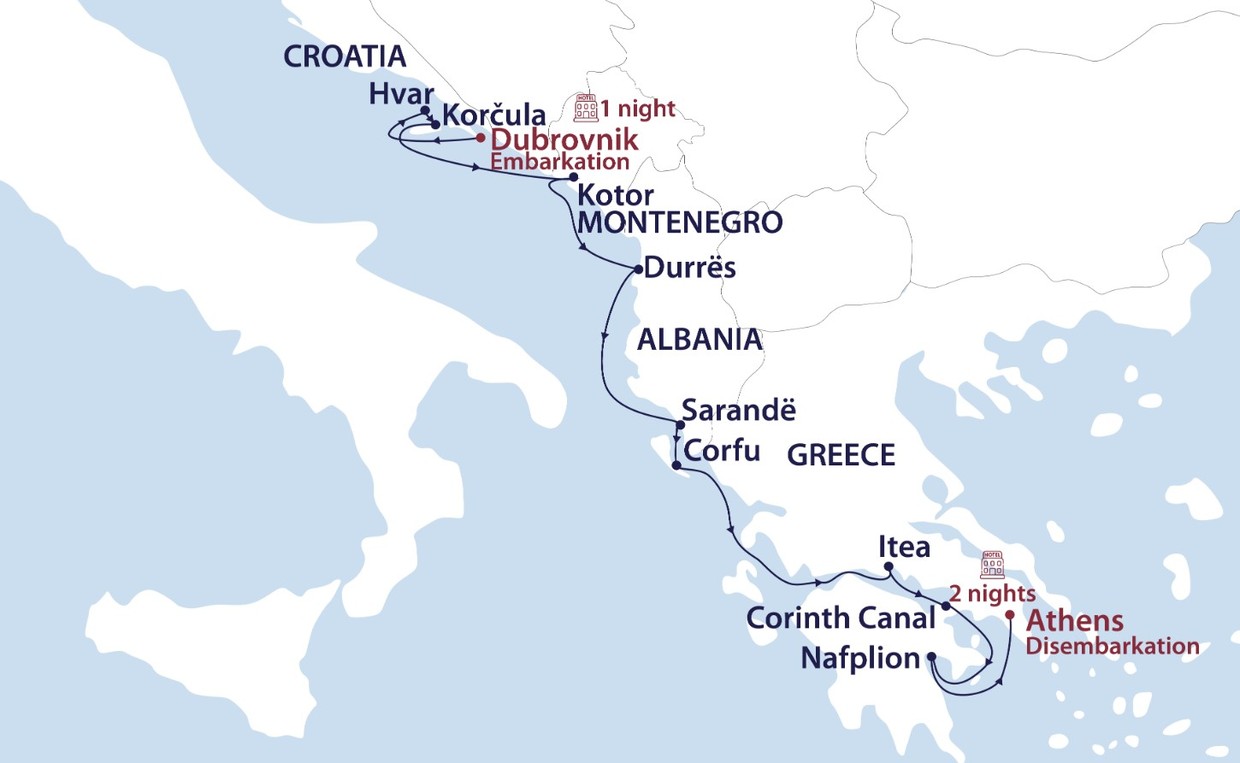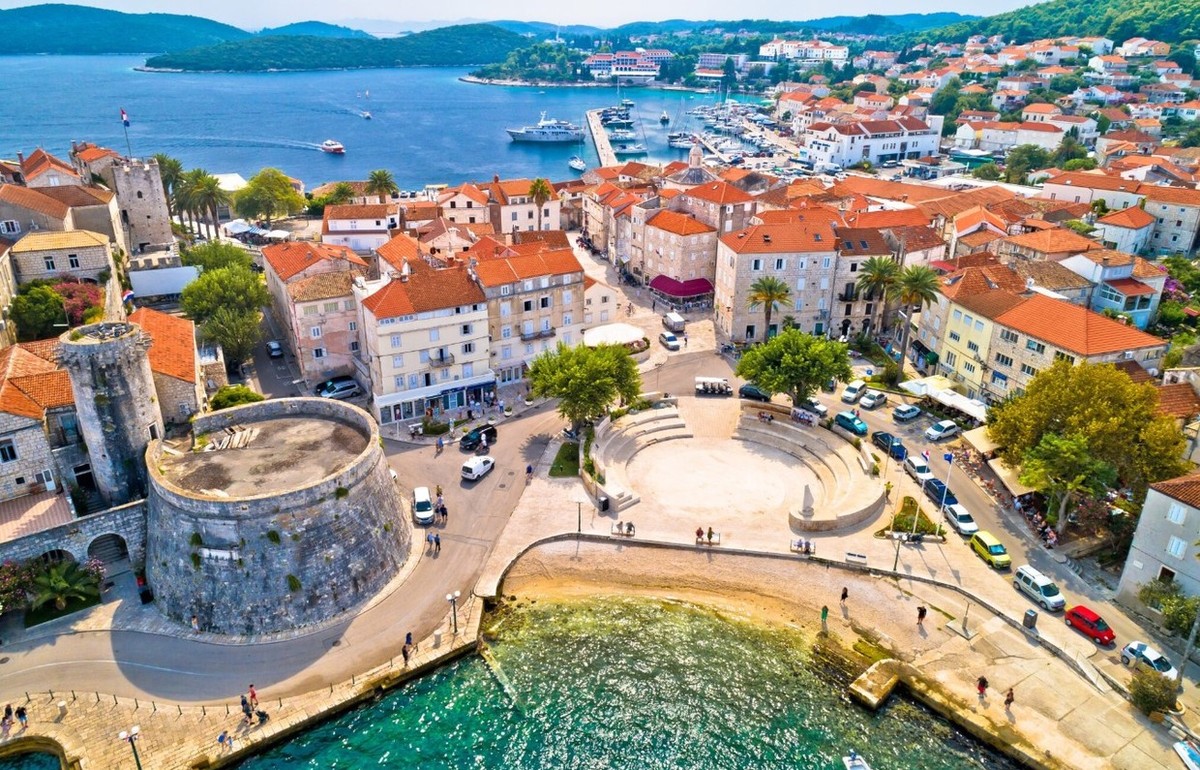
Welcome to Aurora Expeditions' The Tide of Time
Explore the dynamic coastlines of Croatia, Montenegro, Albania and Greece, where centuries of history unfold amid stunning landscapes and vibrant cultures. From the enduring legacies of Ancient Greece and Rome to the diverse influences of the Byzantine, Ottoman and Venetian empires, these lands abound with tales of conquests, alliances and cultural exchanges that resonate today.
Approaching by sea, we marvel at Dubrovnik’s imposing city walls and savour the charm of Kotor’s fjord-fed waterfront. We discover Albania’s hidden gems, long hidden by travel restrictions, and sail to the picturesque ‘holiday island’ of Corfu, before navigating the engineering marvel of the Corinth Canal and exploring the mystical Oracle of Delphi. Our journey ends in Athens, where myth and modernity seamlessly blend amid ancient ruins, and a bustling city life embodies ‘everything Mediterranean’.
This voyage promises an exploration of one of Europe’s most diverse regions, revealing enduring legacies that make this corner of the Mediterranean a must-see destination.
- Uncover centuries of history as you sail the coast of Croatia, Montenegro, Albania, and Greece
- Navigate historic waterways, and coastal cities, traversing the engineering marvel of the Corinth Canal
- Explore UNESCO sites, from the fortified walls of Dubrovnik and Kotor to the ruins of Butrint, and Delphi
- Experience the cultures of the coast enjoying traditional klapa singing, wine tasting and market visits
- Experience the diverse legacies of the Mediterranean, from the Ottoman influences in Gjirokastra and the medieval streets of Kotor to the classical heritage of Athens
- Witness Albania’s varied history from ancient times to its cold war era and emerging travel scene
Prices quoted here are often dependent on currency fluctuations. Please check with (01432 507450 or info@small-cruise-ships.com) for the very latest price, which may well be cheaper than the one advertised here.
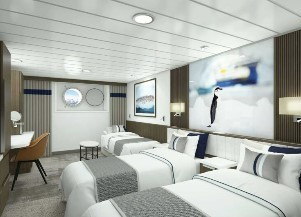
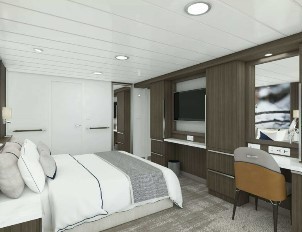
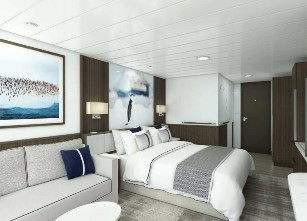
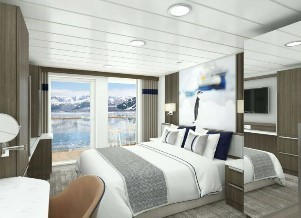
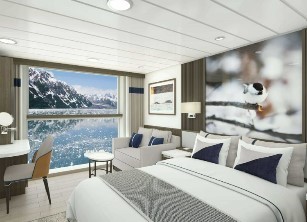
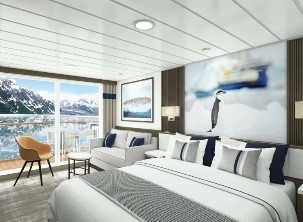
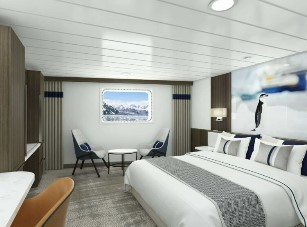
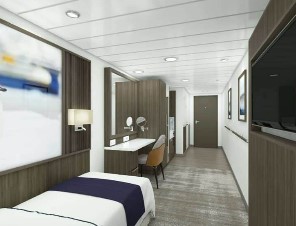
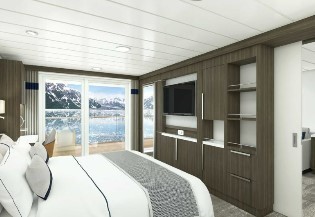
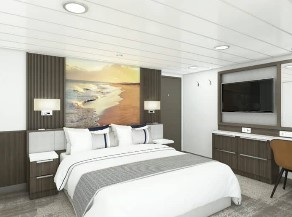
Welcome to Croatia. On arrival at Dubrovnik airport, make your way to the Arrivals Hall to meet our representative, followed by a transfer to our group hotel. At the hotel, visit our hospitality desk in the lobby, to meet our team, who will provide you with useful information regarding pre-embarkation procedures and about your time in Dubrovnik. You will also receive cabin tags for your luggage. Please clearly label the tags with your name and your cabin number on the ship.
Your day is at leisure to explore independently, enjoy the hotel facilities or simply relax after your flight.
This evening, we invite you to join us in celebration to start our journey, where you will meet your host and fellow passengers at a Welcome Event.
Accommodation: Dubrovnik Hotel
Meals: Welcome Event canapés
Experience a ‘Your Choice’ adventure before boarding the Douglas Mawson. If you prefer a morning excursion, you’ll have ample time to explore Dubrovnik until mid-afternoon. We’ll arrange a convenient transfer from our hotel to the port, making your embarkation smooth and effortless. Once aboard, you’ll have time to settle into your cabin before our essential safety briefings. Later in the evening, join us for a Welcome drink with the crew and the Aurora Expeditions team, followed by dinner as we set sail across the Adriatic.
This stunning walled city boasts a history spanning over a millennium. Founded in the 7th century, Dubrovnik thrived as the Republic of Ragusa, a prominent maritime power. Its strategic location encouraged trade across the Mediterranean, with the associated wealth shaping its unique blend of architecture and culture. Throughout its history, Dubrovnik faced periods of prosperity and challenges, including conflicts with rival states and invasions. The city’s formidable defensive walls, begun in the 9th century and expanded in the 14th and 15th centuries, symbolise its strategic significance. In modern times, Dubrovnik gained global recognition as a filming location for motion pictures such as “Game of Thrones,” where its ancient walls and historic streets provided the backdrop for King’s Landing. Today, Dubrovnik’s well-preserved medieval architecture, including churches, monasteries, and palaces, continues to attract visitors seeking to explore its rich heritage and cinematic allure along the scenic Adriatic coast.
Personalise your exploration with our included ‘Your Choice’ experiences.
Option 1 – Morning experience: Locally Guided Walking Tour of Dubrovnik and its City Walls
Experience the essence of Dubrovnik with a locally guided walking tour that includes a stroll along its iconic city walls. Beginning at Pile Gate, built in 1537 and adorned with a statue of St Blaise, patron saint of Dubrovnik, the tour takes you through the bustling Stradun, past historical buildings, shops and cafes. Discover landmarks like Onofrio’s Fountain, the Franciscan Monastery, boasting Europe’s oldest pharmacy, and the majestic Rector’s Palace. The highlight awaits as you ascend the ancient city walls, started in the 9th century and fortified through the 15th century against Turkish attacks. Stretching almost two kilometres in length and rising 25 metres high, these walls offer panoramic views of the Adriatic Sea and the terracotta rooftops below. Explore forts and towers, each steeped in history, while glimpsing into hidden gardens and courtyards along the residential fringes. From the northern Minčeta Tower to Fort Bokar at the southwestern corner, and ending at Fort St John by the Old Harbour, the walls provide insights into Dubrovnik’s resilience, contrasting with remnants of shelling damage from the 1990s conflict. A walking tour of Dubrovnik’s Old Town and city walls promises an unforgettable journey through time.
Option 2 – Morning experience: Walking Dubrovnik and St Vicenzo Dominican Monastery Herbal Gardens
Embark on a guided walking tour through Dubrovnik’s Old Town, starting at the historical Pile Gate, built in 1537 and featuring a statue of St Blaise, Dubrovnik’s patron saint. Wander down the bustling Stradun, passing by historical buildings, shops and cafes. Explore landmarks such as Onofrio’s Fountain, the Franciscan Monastery boasting Europe’s oldest pharmacy, and the grand Rector’s Palace.
After delving into Dubrovnik’s vibrant history, journey to the lush valley of Zupa Dubrovacka, to discover the St Vicenzo Dominican Monastery. Here, among olive trees and aromatic herbs, experience centuries-old traditions of essential oil and honey production dating back to the 17th century. Learn about the meticulous olive oil production process and the art of beekeeping through informative presentations displaying Croatian traditions. Indulge in tastings of homemade cheeses, pancetta and cured meats, accompanied by smashed olives and savoury delights.
Option 3 – Full-day experience: Oysters, Olives and the Ancient Walled City of Ston
Our day is filled with local treasures as we scour the landscape for tastes of the sea, visit the hills, and see a wall to rival all. The ancient city of Ston, on the Pelješac Peninsula, boasts Europe’s longest ancient walls, built by the Republic of Dubrovnik in the 14th and 15th centuries. Extending over five kilometres, these fortifications offer sweeping views of the town and its famed salt pans. Walking atop these historical ramparts is a journey through history, revealing Ston’s role as a vital salt-producing centre and maritime stronghold.
In nearby Orašac, the Lujak family’s olive oil mill stands as a testament to Dubrovnik’s agricultural heritage. Built 260 years ago, it features thick stone walls housing millstones, a press, ancient oil containers, and more. Acquired by the Dubelj family in 1995 and opened to visitors in 2003, the mill continues to produce golden olive oil, preserving rural traditions for future generations. Further south, in Mali Ston Bay, oyster farming dates to Roman times, with the area renowned for Ostrea edulis oysters. Join an authentic oyster-tasting tour, enjoying freshly harvested oysters for a true taste of the Adriatic Sea.
With over 2,700 hours of sunshine annually, Hvar is a prime destination for sun-seekers. Unlike many islands on the Croatian Adriatic coast, it boasts a large coastal plain and freshwater springs, which contribute to its lush landscapes and hillsides adorned with pine forests, vineyards, olive groves, fruit orchards and lavender fields. Steeped in history, Hvar’s architecture reflects its rich past, from ancient Greek settlements to Venetian-era buildings. The island also bears marks of Napoleonic influence, with the French ruler’s occupation leading to the construction of roads and fortifications that still stand today. With pristine beaches, a vibrant cafe lifestyle, and scenic, agriculturally rich countryside, Hvar offers a broad spectrum of ‘Your Choice’ experiences. We tender ashore this morning to the old town of Hvar, where you Hvar journey begins.
Personalise your exploration with our included ‘Your Choice’ experiences.
Option 1 – Morning experience: Walk Hvar with Klapa Concert
Our morning begins with a locally guided tour of Hvar town, where we explore its ancient streets, historical landmarks and viewpoints. Wander through the charming Loggia, the Franciscan Monastery, and the Benedictine Monastery lace museum, before ascending the steps of the Spanish Fortress to enjoy sea views. At St Stephen’s Square, we discover the Renaissance St Stephen’s Cathedral and the historical Hvar Theatre. Inside St Stephen’s, we are treated to a magical klapa performance.
Klapa singing, a traditional Croatian musical style featuring a capella performances, is rooted in Dalmatian culture. Characterised by harmonious melodies and emotional depth, it typically involves male groups, though female and mixed ensembles are becoming popular. Traditionally performed in Croatian, the lyrics often reflect themes of love, life by the sea, and regional folklore. Recognised by UNESCO, klapa epitomises the region’s cultural heritage and is a highlight of any journey to Croatia.
Option 2 – Morning experience: The Village of Jelsa and Winery Visit
The charming town of Jelsa welcomes us this morning as we join our local guide for a walking tour and immerse ourselves in the town’s relaxed atmosphere. Once a bustling fishing centre, in the 19th century Jelsa boasted a significant fleet of trading sailboats, contributing to a profitable fishing era that spanned 50 years and reached as far as Lampedusa and the Mediterranean. In 1868, during a period of national revival, Jelsa opened the first Croatian reading room and library on the Dalmatian islands. By 1878, the library proudly flew the Croatian tricolour flag, and in 1880, Jelsa’s school became one of the first in Dalmatia to offer lessons in the Croatian language. Wander through the old town’s narrow lanes lined by stone houses, quaint shops and traditional cafes, and enjoy the scenic waterfront promenade and the Church of St Mary, with its impressive bell tower.
Continue your journey with a visit to the family-owned Duboković Winery. Join celebrated third-generation owner Ivo Duboković for a guided tour and exclusive wine tasting. Learn about the traditional winemaking process and savour a selection of wines, each with its unique character and flavour profile. Complement your tasting with traditional Dalmatian snacks, including prosciutto, cheese, olives and freshly baked bread. This half-day excursion offers a unique blend of history, culture and culinary delights.
Option 3 – Morning experience: UNESCO-listed Stari Grad Plain – Visit a Family Lavendar Estate
Begin your captivating journey with a visit to the Hora family estate, located in the heart of Hvar’s countryside. Surrounded by rolling vineyards, olive groves and fragrant lavender fields, the estate is part of the UNESCO-listed Stari Grad Plain, an agricultural landscape cultivated since ancient Greek times.
The Stari Grad Plain, also known as Hora or Ager, represents one of the best-preserved examples of ancient Greek agriculture in the Mediterranean. Founded by the Ancient Greeks in 384 BCE, the plain’s original layout has been meticulously maintained, with old stone walls preserving its historical charm across the open, fertile land. This remarkable preservation earned it a spot on the UNESCO World Heritage list in 2008.
We spend this morning on a family lavender farm. Guided by local experts we follow the distillery process, highlighting the importance of lavender to the local economy. Enjoy a delightful experience with refreshments, brunch and a selection of fresh drinks. The Hora family estate offers a unique blend of history, culture and rural community, gifting us an insight into island and rural life in Croatia.
Option 4 – Full-day experience: Walking Tour of Jelsa and Hvar Town and Traditional Lunch at a Family Farm
The journey begins with a scenic drive to the charming town of Jelsa, where you can either join a guided tour or explore at your own pace. This picturesque town offers a chance to learn about Hvar’s historical fishing families, before we head inland to the Kuzmičić family’s renowned Kod Kucera family farm, known for its delicious local products and stunning views of Brač Island and the Makarska Riviera. Our visit offers a taste of the traditional Croatian dish ‘meat under the bell’ (peka), a flavourful slow-cooked hot-pot dish, while the Kuzmičić family show us the farm’s traditional tools and introduce us to their animals.
After lunch, you will return to Hvar town for a locally guided tour. Here, we learn about the town’s rich history, explore its historical architecture, and discover hidden gems often overlooked by visitors. This comprehensive tour offers a unique insight into the heart of Hvar and its focus on community, making this experience one to remember.
We anchor off the island of Korčula this morning, and tender to shore. Our ‘Your Choice’ experiences fill your morning, with your afternoon free to relax onboard, or return to town for a self-exploration. We sail south late afternoon with our eyes set on the emerging travel destination of Kotor.
At 46 kilometres long and just over 7 kilometres wide, Korčula is one of Croatia’s smaller islands, yet its population of 15,000 makes it the country’s second most populous. Often referred to as ‘Little Dubrovnik’ for its medieval squares, churches and palaces, Korčula is steeped in Venetian architectural influence, a legacy of the stonemasons who flocked here during the Venetian era. The island is covered in dense woods and lush Mediterranean shrub, its coastline hiding many pristine bays and coves, whose numerous small villages produce olive oils, liquors, and some of the best white wines in Croatia; notably Grk and Pošip, which can only be enjoyed locally.
Korčula’s most notable claim to fame is as the birthplace of the indomitable explorer Marco Polo, with his legacy celebrated through place names and a dedicated museum. Cultural traditions thrive here, especially the Moreska sword dance, a captivating 16th-century performance, and Klapa, a popular form of cappella singing. With its blend of Adriatic charm and cultural heritage, Korčula offers a unique glimpse into the heart of Dalmatian life, making it a top destination for travellers to Croatia.
Personalise your exploration with our included ‘Your Choice’ experiences.
Option 1 – Morning experience: Walk Old Korčula Town
Join our walking tour of Korčula’s medieval walled Old Town this morning, led by a local guide. Starting directly from the pier, just 50 metres from one of its gates, we enter the meticulously laid out Old Town, designed in a fishbone pattern, with 26 cobblestone streets that naturally harness cooling winds.
Our walk includes a visit to the Cathedral of St Mark, showcasing the exquisite craftsmanship of Korčula’s renowned stonemasons, whose work adorns buildings worldwide. Explore the Bishop’s Palace to uncover its hidden treasures, including sketches and drawings attributed to Leonardo da Vinci, Michelangelo, Raphael, Tiepolo, and others. We will also visit the charming Church of All Saints, home to a remarkable collection of Byzantine icons. Korčula is celebrated as the birthplace of Marco Polo, and you can glimpse the exterior of his alleged birth house during our tour.
Afterwards, return to the ship for lunch, with views of the island and the Croatian coastline, or stay on the island for a further stroll, climb the Revelin Tower for a bird’s-eye view, or relax at one of the many waterfront cafes.
Option 2 – Morning experience: Rural Korčula and Boutique Wine Tasting
Start your tour with a scenic drive through Korčula’s beautiful Mediterranean landscape. Korčula Island is famous for its white wines, making this tour perfect for wine lovers seeking an authentic local experience. After a short drive, you will reach Tasovac Winery, an award-winning, family-owned estate offering a traditional coastal atmosphere and a tasting of their exquisite wines.
Our scenic drive passes through small villages and vineyards, until we arrive at Toreta Winery, located in the heart of Korčula Island. Korčula is renowned for its indigenous grapes, Grk and Pošip. The village of Lumbarda is famous for its Grk wines, while the island’s interior villages are known for their Pošip wines, often compared to sauvignon blanc and chardonnay. Toreta Winery, a small boutique estate, is celebrated for its exceptional wines, liqueurs and olive oil. Here, you can also see old agricultural tools used for generations. After tasting, we return to Korčula town.
Option 3 – Morning experience: A Taste of Korčula
Our morning starts with a short walking tour of Korčula town. We enter the meticulously laid out Old Town, designed in a fishbone pattern, with 26 cobblestone streets that naturally harness cooling winds. We uncover the town’s hidden treasures among its laneways and alleys, churches and bell tower, waterfront walls and eclectic shopfronts. Our journey continues as we leave town and head up the road to one of Korčula’s latest treasures.
Located a mere two kilometres from Korčula town, OPG Komparak greets visitors with a 300-year-old row of cypress pines shadowing a private entrance. This small distillery began production in the winter of 2020 amid a honey deficit. Beekeeper Vlaho Komparak, inspired by the abundance of bitter oranges in Korčula gardens, created Trut gin. Honey is added before distillation to unify the aroma, and each bottle is dipped in beeswax. The first flavour, ‘Signature’, won silver at the Berlin International Spirits Awards, and since then, this sweet gin has become a Korčula success story.
We enjoy the Honey & Gin Experience at this organic farm, featuring an active beehive, gin distillery and olive oil production. We combine a tour of the farm with a tasting of honey, olive oil, marmalade, and the award-winning Trut gin.
Early morning we enter the fjord system leading us to the bayside city of Kotor. Montenegro’s Bay of Kotor boasts stunning steep cliffs descending to a narrow inlet of the Adriatic Sea. Unlike true fjords shaped by glaciers, this bay is a ria—formed when rising sea levels submerged an ancient river valley. Characterised by its branching outline and large estuary, a ria like the Bay of Kotor offers exceptional natural harbour conditions. The bay’s unique bay-within-a-bay configuration, featuring the 300-meter-wide Verige Strait, adds to its striking beauty.
Our tenders transfer us ashore from our point at anchor in the Fjord to Kotor, where we find a selection of experiences. The boutique Balkan country of Montenegro, famed for its rugged mountains and stunning Adriatic coastline, is home to one of the region’s most enchanting destinations: Kotor. This historical town is packed with medieval charm. Surrounded by towering limestone cliffs and clear waters, the bay itself is a UNESCO World Heritage Site. The people of Kotor and Montenegro are known for their warm hospitality and deep connection to their land and traditions. Montenegrins take considerable pride in their history and cultural heritage, which is reflected in their vibrant festivals, local cuisine, and traditional music. The city’s history, coupled with the stunning landscapes of the fjord and the genuine warmth of its people, makes Kotor a highlight of any voyage.
Personalise your exploration with our included ‘Your Choice’ experiences.
Option 1 – Morning experience: Vistas of Kotor
Our morning begins with a guided walking tour through the charming streets of Kotor’s Old Town, where we pass endless medieval architecture and delve into 2,500 years of history. We visit the iconic St. Tryphon Cathedral, a masterpiece that dates to the 12th century, and hear tales of the city’s past. After soaking in Kotor’s enchanting atmosphere, we drive to the base of the cable-car station and embark on a 10-minute scenic cable-car ride, which offers the stunning views of Boka Bay. Ascending the summit of Lovćen Mountain, be prepared to be captivated by sweeping views of Kotor, the Bay of Kotor, and the surrounding landscapes.
Option 2 – Morning experience: Kotor - Hiking the Ancient City Walls
Join a tour that is ideal for those who love hiking and history, while enjoying stunning views. Discover Kotor’s medieval Old Town on our locally guided walking tour, visiting landmarks that have earned UNESCO World Heritage status, including the iconic Cathedral of St Tryphon, consecrated in 1166.
After exploring Kotor, we hike with our guide along the ancient city walls, built during the 400-year Venetian rule.
As you ascend, you will encounter impressive ruins and breathtaking views of the Old Town below. Reaching St John’s Fortress, the highest point, you can savour vistas over Kotor and Boka Bay. Take a moment to relax, capture photos, and then descend along the remnants of the historical walls. (Please note: This is a steep walk and includes 1350 stairs which are often uneven)
Option 3 – Morning experience: A Taste of Kotor
Experience Kotor with an added touch of local flair on a locally guided wine and food tour. This journey immerses you in Montenegro’s culinary traditions, beginning with home-cooked local specialties made with passion and dedication. Delve into the town’s history on a walking tour before exploring the bustling marketplace, the heart of Kotor, where we sample locally cured smoked ham, cheese, and olives.
Upon arriving at one of the city's cobblestoned squares we sample olive oil, homemade spreads, and freshly baked bread. Savour local favourites like black risotto and mussels in “buzara” sauce, all of which connect you to the rich culinary heritage of the coastal Balkan region. To complete our morning, choose to enjoy a Montenegrin wine, beer, or grappa, for a taste of Kotor’s delicious local flair.
Option 4 – Morning experience: Boka Bays’ Waterfront Wonders
Experience the beauty of Boka Bay on a scenic speedboat cruise, when we visit waterfront villages, church studded islands and some rather unique tunnels. Begin your journey at Our Lady of the Rocks, a solo Baroque church sitting on a manmade islet in the Bay of Kotor. Here, you will find an original church built in 1452, adorned with 68 magnificent paintings by Tripo Kokolja. Our cruise continues to Perast, a charming Baroque village known for its rich maritime heritage. Stroll its cobblestone streets, where historical stone houses reflect the town’s prosperous past. The centrepiece is the grand Cathedral of St Nicholas, a striking 18th-century structure that dominates its famous skyline.
From Perast, our speedboat takes us to the intriguing Submarine Tunnels constructed by the Yugoslav Army, cleverly camouflaged with fake rocks to remain hidden from view, before we journey to Prcanj, a picturesque seaside town celebrated for its 17th- and 18th-century stone villas, remnants of its prosperous history as an administrative centre of the Venetian Republic. Finally, we visit the Church of St Nicholas and the Franciscan Monastery at the foot of Mount Vrmac, where we learn about the Franciscan monks and the town’s notable explorer, Ivan Visin, the first Croat to circumnavigate the globe.
Option 5 – Morning experience: Regal legends & Rural Treasures
We travel the same route as the renowned Irish playwright George Bernard Shaw when he excitedly noted: ‘The road to Cetinje via Kotor is one of the most beautiful in the world.’ Our day starts at the village of Njeguši, famous for its smoked ham and local cheese where we savour these local delicacies alongside honey and wine – an authentic taste of the region. Njeguši is also known for its scenic views and historical significance, as it is the birthplace of the Petrović dynasty, which ruled Montenegro intermittently for two centuries.
Continuing along the beaches of Budva, you will arrive in Cetinje, once the centre of Montenegrin power. Here we tour the residence of the last Montenegrin ruler Nikola I Petrović Njegoš who ruled Montenegro from 1860 to 1918. Although this is no Versailles, the building is full of private artifacts, which tell the intriguing tale of the Royal family, and the countries struggle for independence. After exploring Cetinje, we return to Kotor, with time in town to explore independently before tendering to the ship.
Sailing south, we leave Montenegro and enter the former communist nation of Albania. Located in the south of the Balkan Peninsula, it boasts a rich history and a burgeoning present-day persona. From ancient Illyrian settlements to Roman and Ottoman rule, Albania’s past is reflected in its historical sites, which are among the most notable in Europe. After decades of communist rule, Albania embraced democracy in the early 1990s but faced challenges with political instability and corruption. Today, the nation is undergoing a transformation, embracing democracy and economic reforms after years of isolation. Efforts to strengthen institutions and align with European Union standards are ongoing, offering travellers the opportunity to visit this fascinating country without the crowds. With a stunning coastline along the Adriatic and Ionian Seas, rugged mountains, and UNESCO World Heritage Sites, Albania sits at the crossroads of tourism. Visiting it now allows us to experience its unspoiled beauty and genuine hospitality before it gains wider touristic recognition.
Sitting with pride on Albania’s northern coast, Durrës stands as a testament to its millennia-old history. Originally founded as Epidamnos by the Ancient Greeks in 627 BCE, Durrës boasts a rich mix of Greek, Roman, Byzantine, and Ottoman influences. Its imposing Roman amphitheatre, dating back to the 2nd century AD, is among the largest in the Balkans and can hold up to 20,000 spectators. Another highlight is the iconic Venetian Tower, built in the 15th century, which punctuates its skyline and reflects its diverse architectural heritage. Durrës was also a vital hub during the Byzantine period, serving as a key defensive and commercial centre. The city’s walls, some of which still stand today, were strengthened under Byzantine Emperor Anastasius I, who was born in Durrës. Today, Durrës thrives as a bustling port city. It is Albania’s primary seaport, handling over 90 per cent of the country’s maritime trade. With sandy beaches, lively promenades and a bustling market scene, Durrës offers residents and visitors alike a blend of ancient charm and modern convenience.
Our ‘Your Choice’ experiences offer a chance to immerse ourselves in the ancient, medieval or recent past of this fascinating nation.
Personalise your exploration with our included ‘Your Choice’ experiences.
Option 1 – Morning experience: Tirana’s Paranoid Past
Albania’s capital city has emerged anew from nearly 50 years of communist rule, revealing a vibrant metamorphosis marked by resilience. It is astonishing to imagine that Tirana’s colourful buildings, bustling cafes and green parklands were once forbidden under a tyrannical regime. This morning, our tour centres around this remarkable transformation, focusing particularly on the city’s Cold War past with a visit to an unusual piece of Albania’s past. Bunk’Art 2, a re-imagined communist-era nuclear bunker in Tirana, embodies the city’s cultural revival and remembrance of its solemn past. Unveiled in 2015, this 1000 m² underground space was secretly built beneath the Ministry of Internal Affairs from 1981–1986. Known as ‘Objekti Shtylla’ (Object Pole), it was part of Enver Hoxha’s extensive bunker project, symbolising his regime’s isolationist policies. During his 41-year presidency, Hoxha oversaw the construction of over 700,000 bunkers throughout Albania as a defence strategy against perceived threats. Bunk’Art 2 exposes the paranoia and political persecutions endured by Albanians from 1945–1991, highlighting a dark chapter in Albania’s history. Located in the heart of Tirana’s ministerial district, its damaged dome entrance remains unrestored, a deliberate decision, underscoring its role in preserving Albania’s historical memory. (Sadly, the National Museum is closed until 2028, so we are unable to visit this.)
Option 2 – Full day experience: Kruja Castle and Bazaar
Our day takes us to Kruja, around 45 minutes inland from Durrës. This captivating city perched atop a hill with sweeping views 600 metres above sea level, gifts us an insight into the traditional Albanian lifestyle. Wander through its charming stone streets and explore traditional buildings before we visit Kruja Castle, once the formidable citadel of national hero Gjergj Kastriot (Skanderbeg), renowned for his courageous leadership and successful resistance against Ottoman invaders during the 15th century. Skanderbeg himself claimed that he had received a vision of St George handing him a flaming sword to ‘destroy the enemy’. A highlight is time spent in the vibrant atmosphere of the city’s bustling bazaar – a single street adorned with craft and artisan shops, cafes and quaint antique stores. We wrap up our experience with a traditional lunch, savouring Albanian fare before heading back to Durrës mid-afternoon.
Option 3 – Full day experience: UNESCO Berat, and Çobo Winery
Journey inland one-and-a-half hours’ to Berat, a UNESCO-listed town and a treasure of Albanian antiquity. Berat offers a nostalgic journey into Albania’s rich history. Its most striking feature is the collection of white Ottoman houses ascending the hill to its castle, earning it the title of ‘town of a thousand windows.’ Nestled in a rugged mountain setting, Berat’s allure is its picturesque setting, with cloud-tipped minarets and glimpses of the towering Mount Tomorri, which stands at over 2,000 metres.
Our guide introduces us to the citadel, with views of the ancient Christian quarter across the water. Inside the citadel, we visit the Onufri Museum, with its 16th-century paintings by the renowned Orthodox artist Onufri, before enjoying a traditional lunch at a restaurant within the castle walls. Afterwards, we journey to Çobo Winery to enjoy a tour hosted by the Çobo family, whose wines are produced using the ancient and indigenous grapes, Kallmet and Shesh i Bardhë. We enjoy a hosted wine tasting before returning to Durrës late-afternoon.
Our second Albanian port offers us an opportunity to view one of Albania’s UNESCO-listed sites or spend time with a local family in one of the hilltop villages scattered in the city’s hinterland.
Once an ancient Greek and Roman port known as Onchesmos, Sarandë has witnessed centuries of civilisations, evident in its archaeological sites like the ancient city of Butrint, a UNESCO World Heritage Site. Butrint’s history spans Greek, Roman, Byzantine and Venetian periods, making it a treasure trove of historical artefacts and architecture. During World War II, Sarandë was occupied by Italian and German forces, and the remnants of military bunkers from the communist era still dot the landscape, offering a glimpse into the more recent past.
Today, Sarandë is a bustling holiday destination, renowned for its popular beaches. The city’s transformation in recent years reflects Albania’s progress, with modern amenities and a growing tourism industry. Sarandë’s population, predominantly Muslim with a significant Christian minority, coexist harmoniously, contributing to the city’s welcoming atmosphere and cultural diversity.
Personalise your exploration with our included ‘Your Choice’ experiences.
Option 1 – Morning experience: The UNESCO Site of Butrint
Set in a marshy landscape between Lake Butrint, and the sea, this UNESCO World Heritage Site is an archaeologist’s favourite. Once a flourishing ancient Greek, and later Roman, city, Butrint has a rich history dating back to the 8th century BCE. Initially settled by the Greeks, it later became a Roman colony in the 1st century BCE and thrived, attracting various civilisations, including the Byzantines, Venetians and Ottomans, each leaving their mark on the city’s architecture and culture. Key areas of the excavation include the Roman Forum, the sprawling Triconch Palace, a late-antique baptistery, a Roman villa, and a late-antique church on the shore of Lake Butrint at Diaporit. A highlight of our visit is the ancient theatre, which dates to the 3rd century BCE. Originally built by the Greeks and later expanded by the Romans, the theatre could seat up to 2,500 spectators and was a central part of Butrint’s cultural and social life. Standing among its well-preserved structure, it is easy to imagine the city’s inhabitants enjoying a performance. A visit to Butrint offers the opportunity to explore a lesser-visited site with less rush and more understanding of Albania’s past. This immersive experience allows us to appreciate the layers of history and the diverse cultures that have shaped this remarkable location.
Option 2 - Full-day option: Gjirokastër, the ‘City of Stone’
Gjirokastër sits in the Drino River valley between the Gjerë mountains and the Lunxhëri hills, about an hour-and-a-half’s drive inland from Sarandë. This UNESCO World Heritage Site is renowned for its well-preserved Ottoman architecture and historical significance. Visiting Gjirokastër offers a glimpse into Albania’s cultural past, as we begin our journey at Gjirokastër Castle, perched high above the town. After exploring the castle’s museum and hearing about its time as a fortress and prison, wander through the old town bazaar, with its charming cobblestone streets lined with traditional Ottoman-era houses and shops selling local crafts. Enjoy lunch at a traditional restaurant, savouring authentic Albanian fare such as byrek, the Balkans’ popular filo pies, and tave kosi, Albania’s national dish of lamb and rice. This visit provides a perfect blend of historical exploration and cultural immersion, making for an unforgettable experience in the ‘City of Stone’.
We spend the morning on the Greek island of Corfu before sailing in the early afternoon to the mainland.
Located in the Ionian Sea, the island of Corfu is a captivating fusion of past dynasties, including the Venetians and the British, with notable ties to Queen Elizabeth II consort, Prince Philip, who was born on Corfu. Its rich history is evident in its diverse architectural styles, Byzantine churches, Venetian fortresses, and British colonial buildings. Corfu’s Old Town stands as a testament to its cultural heritage, enclosed by Venetian fortifications. Wandering through its narrow cobblestone streets reveals elegant mansions, Byzantine churches and charming squares. Venetian influences adorn the architecture, with arched colonnades, grand palaces, and picturesque bell towers.
A leisurely stroll along the iconic Liston Promenade, lined with cafes and boutiques, offers views of the surrounding sea and distant mountains. Every street seems to lead to a quintessential British icon: a cricket pitch. Beyond the Old Town, Corfu unveils stunning beaches, verdant hillsides, and picturesque villages nestled in the countryside.
Personalise your exploration with our included ‘Your Choice’ experiences.
Option 1 – Morning experience: Achilleion Palace and the Bay of Palaiokastritsa
Departing from the port of Corfu, we will head to the picturesque village of Gastouri to visit the romantic Achilleion Palace. Built by the Empress Sissi of Austria, renowned for her beauty but also her tragic death, she created this retreat inspired by her love for Greek mythology. Surrounded by classical Greek statues, the palace is a monument to platonic romanticism and escapism, aptly named after Achilles. You will have time to explore the manicured gardens, including the dramatic statue of the Dying Achilles, and enjoy views of the Ionian Sea.
Leaving Achilleion Palace, we will head to the bay of Palaiokastritsa. Here, you will have some leisure time to stroll along the beachfront and through the picturesque village. Next, we have a short visit to the Byzantine Monastery of the Blessed Virgin Mary just outside Palaiokastritsa. Originally dating back to 1228, the current building, including the church, monk cells, and courtyard, was constructed in the 18th century. In the courtyard, a ‘wishing well’ invites visitors to throw coins or pieces of paper with their wishes.
Option 2 – Morning experience: Walking tour of UNESCO World Heritage Site, Old Corfu Town
Explore Corfu’s Old Town on a locally guided walking tour. The Old Town is an icon of the island, full of markets and shops. Wander its narrow cobblestone streets lined with Venetian-style buildings, revealing centuries of history. Discover iconic landmarks like the Liston Promenade and the grand Old Fortress, with expansive views of the Ionian Sea. Immerse yourself in the charm of Spianada Square, Greece’s largest square, surrounded by elegant cafes and historic architecture. Encounter Byzantine churches adorned with frescoes, vibrant markets brimming with local crafts, and hidden tavernas offering authentic Greek cuisine. Let the stories of past rulers, Venetian rule, and British influence unfold as you delve into the rich history of this UNESCO World Heritage Site.
Our morning affords us a glimpse into the life of the early Greeks, with a visit to the Oracle and former city of Delphi. Our local guides tell tales of pilgrimage, sacrifice and early faiths as we step into the world of Ancient Greece.
Revered throughout antiquity as a sacred site where pilgrims could glimpse the future, the Oracle of Delphi cast cryptic prophecies for over a millennium. Dubbed the ‘navel of the world’ for its pivotal position in the Greek realm, Delphi drew pilgrims from all sectors of society, shaping critical decisions, from civic politics to personal destinies. Perched dramatically on the slopes of Mount Parnassus, the Oracle was esteemed as a direct conduit to the divine realm of Apollo – the sun god. Revered for his beauty and creative prowess, Apollo symbolised order and harmony. As a result, Delphi became integral to Greek identity, reflecting its religious, cultural, and political life. It was a unifying site where people from various city-states gathered, fostering a sense of shared Hellenic heritage.
Our journey leads us to the very site of the Oracle, alongside the opulent Treasury of the Athenians – a testament to offerings made. We pause at the ancient theatre, host to the prestigious Pythian Games, and the Castalian Spring, where pilgrims purified themselves before seeking counsel.
Today, Delphi stands as a UNESCO World Heritage Site, its influence enduring through the annals of literature, history, and art. It remains a profound emblem of ancient wisdom and cultural legacy, cherished by Greece as a bridge to its storied past.
Returning to the ship, we have lunch, and time to relax. Enjoy a swim in the pool, or a cool drink up on deck, as we sail towards one of the world’s engineering wonders. In the early evening, we navigate the Corinth Canal. This narrow waterway connects the Gulf of Corinth with the Saronic Gulf in the Aegean Sea, cutting through the Isthmus of Corinth and saving vessels a significant 700-kilometre journey around the Peloponnese peninsula. Stretching 6 kilometres and only 21 metres wide at its base, the Corinth Canal is one of the narrowest lock-free canals in the world. Its towering limestone walls, reaching heights of up to 90 metres, create a dramatic passage for vessels, which almost touch its sides as they sail its path.
The concept of cutting a canal through the isthmus dates to ancient times, with plans proposed by Periander of Corinth in the 7th century BCE. Construction finally began under Roman Emperor Nero, only to halt upon his death. It was not until 1893 the canal was finally completed. Its construction was a monumental effort, involving the excavation of millions of cubic metres of earth and rock, all dug at sea level. It stands as a remarkable achievement in engineering and continues to be a key route for maritime traffic, enhancing Greece’s role as a central hub in the Mediterranean.
Exiting the canal, we sail overnight to the Peloponnese Peninsular and the waterfront town of Nafplion.
Sitting on the northeastern coast of the Peloponnese peninsula, this historical town overlooks the Argolic Gulf, framed by surrounding mountains. Serving as the first capital of independent Greece, between 1833 and 1834, Nafplion boasts a wealth of historical landmarks that bear witness to its illustrious past. Serving as the gateway to major UNESCO World Heritage Sites Epidaurus and Mycenae, Nafplion offers visitors a memorable day out.
Our final evening is spent as a fond farewell to Douglas Mawson, her crew and Aurora Expeditions team as we sail the Aegean to Greece’s capital, Athens.
Personalise your exploration with our included ‘Your Choice’ experiences.
Option 1 – Morning experience: Nafplion Walking Tour with Ouzo Factory Tour and Tasting
Our locally guided walking tour begins as soon as we disembark, at the old port, where we begin our exploration of the town’s most important sites. From here we can view the iconic Palamidi Fortress, perched atop a rocky hill overlooking the town, standing as a testament to Nafplion’s strategic importance throughout the ages. Meanwhile, the old town, with its narrow cobblestone streets, Venetian mansions, and neoclassical buildings, invites visitors to step back in time and immerse themselves in centuries of Greek history and culture. Karonis Distilleries, a family-run business in Nafplion, has been crafting ouzo, tsipouro, and masticha for 145 years. Managed by Fotis and Yiannis Karonis, this distillery uses modern copper stills to produce high-quality spirits. Just two minutes from the town centre, we tour the distillery, taste the products, and explore a museum filled with artefacts from 1870.
No visit to the Peloponnese is complete without a taste of Greece’s most popular brew. Ouzo, a beloved Greek spirit, is an integral part of Greek culture and social life. It is often enjoyed at gatherings and celebrations, symbolising Greek hospitality and tradition. Visitors can also sample the Karonis’s distinguished cherry liqueur, made from Arcadian cherries. Both drinks, shared with friends and family, highlight the rich flavours and heritage of Greece, making a visit to Karonis Distilleries a delightful and educational experience.
Option 2 – Morning experience: UNESCO World Heritage Site of Mycenae
This morning, we journey through time and explore the remains of the ancient city of Mycenae, which was a major centre of Greek civilisation from 1600 BCE to 1100 BCE and one of the most important cities of Ancient Greece.
Our local expert guides us through time, bringing daily life in this ancient city alive among its relics and ruins.
This sprawling UNESCO World Heritage Site brings the Bronze Age city of Mycenae to life, as our curiosity travels beyond archaeology, fuelling our fascination for the heroic age of Greek mythology. Renowned for its impressive fortifications, monolithic architecture, and rich archaeological finds, Mycenae has played a crucial role in shaping ancient Greek history and mythology. Ruled by legendary figures such as King Agamemnon, who according to myth led the Greeks in the Trojan War and was later murdered upon his return to Mycenae, the city’s story is central to Homer’s epic poems, the ‘Iliad’ and the ‘Odyssey’.
Archaeological excavations at Mycenae have unearthed a wealth of artefacts, including intricately decorated pottery, gold jewellery, and the famous ‘Mask of Agamemnon’, a gold funeral mask discovered in a royal tomb. These discoveries provide insights into the wealth, artistry, and sophistication of the Mycenaean civilisation. The site’s significance extends beyond archaeology, as it continues to inspire artists, writers and scholars, fuelling fascination with the heroic age of Greek mythology and the legacy of ancient civilisation.
Option 3 – Morning experience: UNESCO World Heritage Site of the Sanctuary of Asklēpiós and Epidaurus
This morning we tour one of Greece’s most revered sites and the world-famous Ancient Theatre of Epidaurus. A significant centre of healing, Epidaurus remains a symbol of humanity’s quest for self-preservation, with Asklēpiós’ staff and wrapped snake recognised as a sign of the medical profession even today. Acknowledged as the legendary birthplace of Apollo’s son, Asklēpiós – the god of medicine – Epidaurus’s fame spread as pilgrims seeking cures for their ailments flocked to the site, and particularly the temple of Asklēpiós, which is today a UNESCO World Heritage Site. Treatments, combining religious rites with practical medical practices, ranged from herbal medicines to therapeutic snake licks. Clients travelled great distances to reach the site, which included a hospital, a guest house, mineral springs and a gymnasium.
The Ancient Theatre of Epidaurus, built in the 4th century BCE to accommodate the crowds, is considered one of the most well-preserved ancient theatres in Europe. With a capacity of around 14,000 spectators, the theatre hosted dramatic performances that were an integral part of the healing rituals, as the Greeks believed in the therapeutic power of the arts.
Today, Epidaurus continues to influence the world through its contributions to both medicine and the arts. The ancient theatre still hosts performances during the annual Epidaurus Festival, while the site’s emphasis on holistic healing resonates with modern integrative medicine approaches, blending physical treatments with psychological and spiritual well-being. As a UNESCO World Heritage Site, its legacy as a centre for healing and culture highlights the enduring influence of ancient Greek civilisation on modern medicine and the arts.
After breakfast, disembark at the port of Piraeus and join a ‘Your Choice’ Athen's experience, with time to enjoy a free afternoon in Athens, before transferring to our overnight hotel.
With a rich recorded history spanning 3,500 years, Athens is a city brimming with stories. Widely hailed as the ‘cradle of civilisation’ and revered as the birthplace of democracy, philosophy and theatre, Athens seamlessly merges its illustrious past with its vibrant present. This bustling metropolis, home to three million inhabitants, is adorned with a wealth of ancient sites that punctuate its landscape like temples, iconic columns and former city centres. Athens’ influence in antiquity transcended its borders, ushering in a Golden Age characterised by political discussion, education and philosophy, hosting luminaries such as Socrates, Plato and Aristotle. The democratic principles forged in Athens laid the groundwork for modern governance systems worldwide.
Yet, Athens is more than just a relic of ancient history. As a historical seat of power, it has weathered waves of invasions, shaping its contemporary identity with a diverse fusion of architectural styles, culinary delights and cultural traditions. Whether you are wandering amid ancient ruins or indulging in the flavours of modern Greek cuisine, Athens offers a captivating journey through the ages, beckoning travellers from across the globe to explore its timeless allure.
Personalise your exploration with our included ‘Your Choice’ experiences.
Option 1 – Morning experience: A Taste of Athens
For foodie fans, travellers who have visited Athens before, or those who simply enjoy a personal view of Athens, this experience is perfect. We commence our walk at Syntagma Square, where Greece’s Parliament building stands, guarded by traditionally attired Evzone guards. Our local expert warmly welcomes you to their home city, leading you on an intriguing walking tour through Athens’ historical areas. With passion and knowledge, they unveil authentic Athens and its secrets.
Stroll through Plaka, the charming ‘old quarter’ of Athens nestled at the base of the Acropolis. Admire its eclectic neoclassical architecture, picturesque alleys, and inviting tavernas. Pause at a colourful local cafe to indulge in Greek delicacies such as olives, fragrant cheeses and cured meats.
Continue through Monastir Aki, famous for its bustling flea market and vibrant shops brimming with local crafts and souvenirs. From there, we wander to Thission, offering the best panoramic views of the Acropolis, Ancient Agora, and the majestic Temple of Hephaestus. Here, we treat ourselves to a traditional Greek coffee, accompanied perhaps by a sweet delight like baklava, a favourite among Greeks for its rich layers of pastry, nuts and honey. Our morning offers us a taste of this fascinating city.
Option 2 – Morning experience: Classic Athens – the Acropolis and Athens
This comprehensive tour combines a visit to the Acropolis with the city’s major landmarks. Begin with a view of the Greek parliament at Syntagma Square, once a royal residence, where the iconic Evzones still stand guard in traditional attire. Next, enjoy a brief photo stop at the Panathenaic Stadium, the site of the first modern Olympic Games in 1896, where athletes revived the ancient Olympic spirit.
Continue past the Temple of Zeus and the Zappeion and view the National Library and University of Athens before a scenic drive to the Acropolis of Athens, a UNESCO World Heritage Site. Built in the 5th century BCE, the Acropolis served as a citadel and religious centre dedicated to Athena, the city’s patron goddess. Explore remarkable structures like the Parthenon, Propylaia, Erechtheion, and the Temple of Athena Nike, showcasing the grandeur of Ancient Greece.
Perched high above the city, the Acropolis is not only an architectural marvel, but also a symbol of the birthplace of democracy. This ancient citadel stands as a testament to the enduring legacy of Greek culture and ideals, representing advancements in art, architecture and political thought that originated in Athens. Feel the essence of civic pride and religious devotion in ancient Greek society, at the city’s centre for political and cultural life. The Parthenon exemplifies the height of classical Greek architecture, adorned with Doric columns and intricate sculptures. Built under the leadership of Pericles, the Parthenon symbolised the city’s wealth and power, with friezes and statues depicting various mythological scenes.
After touring the Acropolis, take a short walk to the Acropolis Museum. This modern museum houses over 3,000 artefacts from the Athenian Acropolis, offering unique insights into ancient Greek life and including an archaeological excavation beneath it. *Please note: Entrance time to the Acropolis is a local government stipulated time slot. The sequence of the above itinerary may change once the specific time slot is allocated.
Rejoin the coach for a short drive or take a stroll to the city’s popular Plaka precinct nearby. A series of streets and laneways filled with restaurants, cafes and shops, it is the perfect place to grab a bite to eat or shop for gifts to take home. Mid-afternoon, we transfer to our hotel. (lunch own expense).
Accommodation: Athens Hotel
Meals: Breakfast
Enjoy a leisurely day in Athens. Revisit your favourite sites, relax by the hotel’s pool, or discover hidden treasures on your own exploration. Athens’ extensive metro network makes it easy to navigate the city, while the warm Greek hospitality ensures you are never far from helpful advice on how to make the most of your visit.
This evening, we celebrate the end of our journey in true Greek style, with a Farewell event.
Accommodation: Athens Hotel
Meals: Breakfast, Farewell Event canapés
After breakfast, check-out of your hotel and transfer to the airport for your onward flight.
Meals: Breakfast
Itineraries are subject to change.
Douglas Mawson
Vessel Type: Small Ship Expedition
Passenger Capacity: 154
Lenght: 104.4 m
Built: 2025
Designed for global discovery
Adventure has a new name. Setting sail in 2025, our new state-of-the-art ship, the Douglas Mawson, is the last in a line of purpose-built vessels that have redefined small ship expedition cruising.
Named after the legendary Australian geologist and explorer, our new small ship embodies Mawson’s pioneering spirit and is designed for global discovery. Featuring the revolutionary Ulstein X-BOW® and purpose-built with enhanced sustainability features, it takes on average 154 adventurers to the world’s wildest places in smooth, quiet comfort. It boasts our most extensive range of cabins yet, including a range of single cabins.
The Douglas Mawson features a host of amenities to help you connect with like-minded travellers and elevate your time onboard our floating base camp for adventure. After a long day of exploring, head to the back deck to swim in the heated outdoor swimming pool, find a sun bed to read on, or soak in one of two Jacuzzis. Work up a sweat in the gym before unwinding in the sauna, resolve to learn something new in the Citizen Science Centre, then enjoy a delicious meal with new and old friends in one of two restaurants. Or, with multiple observation areas throughout the ship, simply relax in comfort while you keep watch for wildlife or incredible landscapes unfold before you.
While enjoying the luxurious amenities onboard, you can rest assured that our aim to get you off the ship to explore the natural environment as much as possible through our unique activities program remains unchanged.
Newest Ulstein X-BOW®
The Douglas Mawson features the newest streamlined Ulstein X-BOW®, designed for global discovery. The revolutionary design cuts through the swell, offering unrivalled stability on ocean crossings and helping to reduce fuel consumption. It’s just one of the many sustainability features that helps us travel more responsibly.
Heated Pool, Jacuzzis & Sauna
In between landings, enjoy access to the onboard gym or unwind in the sauna. Or head to the back deck to swim in the heated outdoor pool, enjoy a drink at the pool bar, or soak in one of two Jacuzzis, watching the world go by.
Leading Technology
The Douglas Mawson is at the cutting edge of nautical technology, fitted with industry-leading technology including world-class return-to-port equipment. The ship also features a medical clinic designed for use in remote areas.
Built for Adventure
The Douglas Mawson features Zodiac access points and an activities platform, making boarding the Zodiacs as quick, efficient and safe as possible, minimising wait times and getting you closer to the action for longer. In our mudroom you will have access to lockers to store gear & boots and rapid drying areas for clothing.
More Cabin Choices
The Douglas Mawson features 11 different types of cabins, including a range of spacious single berth cabins – all adorned with elegant Nordic interior design features.
Multiple Observation Areas
As you explore the ship you will find indoor lounge areas with floor-to ceiling windows, and multiple open decks with expansive 270-360 degree views. The Glass Atrium Lounge inside the bow is a fantastic place to sit and watch for wildlife – with a drink in hand. There is no shortage of spaces to take in the majesty of the incredible world outside!
Lecture Theatre
On all expeditions you will meet naturalists and local specialists, who offer presentations on their area of expertise to enhance your appreciation of the destination you are exploring.
Join the team in the lecture theatre for presentations covering a broad range of topics to suit every interest, from history and culture to biology and climate change. Regardless of the topic, they all have one thing in common: they all aim to engage, educate, entertain and turn you into an ambassador for the planet.
Citizen Science Center & Lounge
Learn more about the world and the unique destinations Aurora visits by visiting the onboard naturalist and Expedition Team in the world-class Citizen Science Center. You will be rewarded for your thirst for knowledge with one of the best views on the ship.
Library
With floor-to-ceiling windows, the library is a peaceful sanctuary where you can find non-fiction books to read up on the day’s destinations, use a public laptop to organise your photos or play board games with newfound friends.
Choose from our range of informative non-fiction titles, wildlife guidebooks, travel journals, novels and a selection of children’s books and board games.
Wildlife guides, books and binoculars can also be found on the observation lounge on Deck 7.
Mudroom
No need to take your wet expedition gear back to your cabin to dry. Keep your cabin warm and cosy by leaving your outer jackets and pants in the mudroom.
The mudroom is your launchpad for all shore excursions and activities. Here, you will have access to a locker when you can hang your gear up to dry, and store your boots between excursions.
Swimming Pool & Jacuzzis
There are two Jacuzzis on the top outside deck which offer amazing views of the world outside, a heated outdoor pool surrounded by sun beds you can relax on after a long day of exploring, and a pool bar.
Gym & Sauna
During your voyage, enjoy complimentary access to the gym or visit our sauna, which we highly recommend after the Polar Plunge!
Restaurants
One of the most important parts of any expedition is the food! Whatever adventures the day holds, you will be fuelled-up with hearty meals and delicious morning/afternoon teas cooked by our onboard chefs.
Meals are a great time to soak up the expedition camaraderie in our open seating dining area. Share stories with your fellow travellers and ask our expedition team questions that may have come up during the day.
Tea, coffee and snacks are available 24 hours a day, and our chefs offer different menu options and courses for each meal. Enjoy the range of house wine, beers and soft drinks included with dinner after a long day in the wild.
We also invite you to join your captain and expedition team for informal Captain’s Farewell drinks, with complimentary beverages and cocktail appetisers, followed by a 3 course meal.
Bars & Lounges
Communal meeting areas have always played a major role in fostering the warm camaraderie on board our ships. They are the heart of the expedition, where people meet to share tales from the day, swap photos, keep an eye out for wildlife and watch the sun go down.
The bars and lounges on board are refined yet inviting places to gather, with floor-to-ceiling windows offering stunning views, and of course friendly bartenders to shoot the breeze with.







